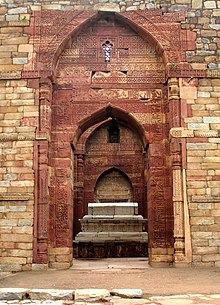Shah Ismail Ghazi
Shah Ismail Ghazi | |
|---|---|
 Iltutmish's mausoleum | |
| Born | unknown Mecca |
| Died | 1474 |
| Cause of death | Slain in a battle |
| Burial place | Ghoraghat, Dinajpur, Bangladesh |
| Title | Warrior Saint of Bengal |

Shah Ismail Ghazi (শাহ ইসমাইল গাজী, شاه اسماعيل غازي) was a Quraish[1] born in Mecca. He was a preacher of Islam as well as a warrior.[2] He came to India in the mid-fifteenth century during the reign of Sultan Barbak Shah and settled at Gaur.[3]
Life[]
Shah Ismail Ghazi was of Arab origin and a descendant of the Prophet Muhammad.[4] He settled in the city of Gaur. During this time Sultan Rukunuddin Barbak Shah was building a dam across the river Jhatiya-Bhatiya or Chutiaputia.[1] All the engineers and craftsmen tried for long seven years but could not complete the dam. After hearing this Ismail approached the Sultan and suggested a scheme. After his solution proved successful, Ismail became one of the most important men in the Sultan's army,[5] and many battles were won under his command.[citation needed]
Battles[]
Shah Ismail Ghazi's first campaign was against Gajapati Kapilendra, the king of Orissa on the south-western frontier.[6] He defeated Gajapati and Mandaran was recovered,[7] and he constructed a fort there.[8][9] After defeat at the hands of Kameshwar, king of Kamatapur, Barbak Shah decided to send Shah Ismail. He was victorious; the king surrendered to the Sultan[10][11] and converted to Islam.[1]
Death[]
There are two theories regarding the death of Shah Ismail Ghazi. One is that he was slain in a war in 1474.[12][6] Another theory says that after so many victories , the commandant of Ghoraghat, was jealous of him and reported to the Sultan that Shah Ismail Ghazi was in collusion with the Raja of Kamrup. After hearing this the Sultan immediately ordered Ismail's execution in 1474 A.D(878 A.H).[5] There are six shrines dedicated to the memory of the saint; one at Mandaran (in Jhanabad, west of Hooghly), one at Ghoraghat, and four in Pirganj in the district of Rangpur, one of those being in .[12]
References[]
- ^ Jump up to: a b c Singh, Surinder; Gaur, I. D. (2008). Popular Literature and Pre-modern Societies in South Asia. Pearson Education India. ISBN 978-81-317-1358-7.
- ^ "part1_06". www.columbia.edu. Retrieved 2020-04-01.
- ^ Banu, U. A. B. Razia Akter (1992). Islam in Bangladesh. BRILL. ISBN 978-90-04-09497-0.
- ^ "Shah Ismail Ghazi (R) - Banglapedia". en.banglapedia.org. Retrieved 1 April 2020.
- ^ Jump up to: a b Hanif, N. (2000). Biographical Encyclopaedia of Sufis: South Asia. Sarup & Sons. pp. 117–118. ISBN 9788176250870.
- ^ Jump up to: a b Sengupta, Nitish K. (2011). Land of Two Rivers: A History of Bengal from the Mahabharata to Mujib. Penguin Books India. pp. 79–80. ISBN 9780143416784.
- ^ "Gold Tanka of Bengal Sultan Rukn Al-Din Barbak Shah". Mintage World. 2019-11-05. Retrieved 2020-04-01.
- ^ Chattopadhyay, Bankim Chandra (2014-02-25). Durgeshnandini. Diamond Pocket Books Pvt Ltd. ISBN 978-93-5083-240-0.
- ^ "Bader Maqams or the shrines of Badr Al-Din-Auliya (Part II) - Kaladan Press Network". www.kaladanpress.org. Retrieved 2020-04-01.
- ^ Neog, Maheswar (1980). Early History of the Vaiṣṇava Faith and Movement in Assam: Śaṅkaradeva and His Times. Motilal Banarsidass Publishe. p. 47. ISBN 9788120800076.
- ^ "Bibliography - History Ancient Period". hozir.org. Retrieved 2020-04-01.
- ^ Jump up to: a b Bhattacharya, Asok K. (1999). Rakhaldas Bandyopadhyay. Sahitya Akademi. ISBN 978-81-260-0848-3.
This article needs additional or more specific categories. (April 2020) |
- 1474 deaths
- Quraysh
- People from Mecca
